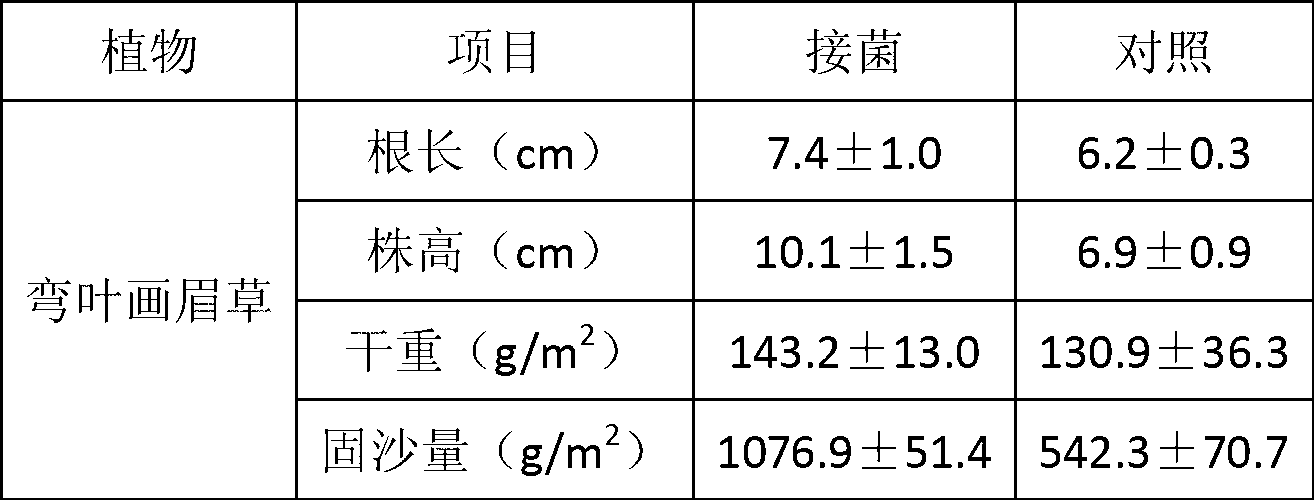Heavy metal resistant nodule bacterium and method of promoting tailings area plant restoration by using same
A phytoremediation and rhizobia technology, which is applied in the fields of agriculture and environmental pollution control, can solve problems such as poor viscosity, strong water permeability, and unfavorable plant growth, so as to reduce soil erosion, promote plant growth, and improve plant stress resistance.
- Summary
- Abstract
- Description
- Claims
- Application Information
AI Technical Summary
Problems solved by technology
Method used
Image
Examples
Embodiment 1
[0027] The heavy metal-resistant plant growth-promoting bacteria W33 bacterial strain of the present invention is isolated and purified from the rhizosphere soil of Leptochloa chinensis (Linn.) Nees in Longshan, Nanjing, and the isolation and identification method is as follows:
[0028] Use sterile tweezers to take the rhizosphere soil that is closely attached to the soil of about 2mm on the surface of the root system, weigh 10g, place it in a triangular flask filled with 90ml of sterile water, shake it fully for 30min, let it stand for 10min, take 0.1ml of the suspension, and use 10-fold serial dilution method, spread on YMA plates containing 0.004% Congo red (sucrose 10.0g, MgSO 4 ·7H 2 O 0.2g, K 2 HPO 4 0.5g, NaCl 0.1g, CaCO 3 3.0g, yeast extract 5g, water 1000mL, agar 20g), culture at 28°C for 3 days, pick a single colony and streak it on a YMA plate for purification and save it. Strains were inoculated in the absence of CaCO 3 In the YMA culture medium, shake cult...
Embodiment 2
[0030] Streak inoculation of W33 (CCTCC NO: M 2012357) in YMA medium containing different concentrations of heavy metals, culture at 30°C for 3 days, and observe its growth and growth conditions. The results are shown in Table 1. W33 strain can tolerate a variety of heavy metals (minimum inhibitory concentrations of Cu, Pb, and Cd are 0.8, 3.6, and 0.4 mM, respectively).
[0031] The growth situation of table 1 bacterial strain on the YMA medium containing different heavy metal concentrations
[0032]
[0033] In the above table, "+" means growth, and "-" means no growth.
Embodiment 3
[0035] Siderophores were determined according to the method of Wang Pingping. W33 (CCTCC NO: M 2012357) was inoculated in YMA liquid medium, and shaken at 150 rpm at 30°C for 48 hours. The fermentation broth was centrifuged at 12000rpm for 5min, the supernatant was taken and mixed with an equal volume of CAS detection solution, and the absorbance value (A) at the wavelength of 630nm was measured after 1h of color development, and deionized water was used as a control to adjust to zero. In addition, the same volume of sterile YMA liquid medium and CAS detection solution were mixed thoroughly, and the absorbance value was measured in the same way as the reference value (Ar). A / Ar values < 1 can be considered as high siderophore producers. The results showed that the A / Ar of W33 (CCTCC NO: M 2012357) fermentation broth was 0.4, and siderophore was highly produced.
PUM
 Login to View More
Login to View More Abstract
Description
Claims
Application Information
 Login to View More
Login to View More - R&D
- Intellectual Property
- Life Sciences
- Materials
- Tech Scout
- Unparalleled Data Quality
- Higher Quality Content
- 60% Fewer Hallucinations
Browse by: Latest US Patents, China's latest patents, Technical Efficacy Thesaurus, Application Domain, Technology Topic, Popular Technical Reports.
© 2025 PatSnap. All rights reserved.Legal|Privacy policy|Modern Slavery Act Transparency Statement|Sitemap|About US| Contact US: help@patsnap.com



